Report: Understanding and Leading Change in a Financial Organisation
VerifiedAdded on 2020/10/05
|12
|3907
|251
Report
AI Summary
This report examines change management within the context of the AEGON financial services company. It begins by comparing AEGON's organizational structure and strategies with those of Prudential Financial, highlighting the impact of structural changes. The report then delves into the internal and external drivers of change, including organizational culture, employee motivation, and a PESTEL analysis of external factors like political, economic, social, technological, environmental, and legal influences. It evaluates measures to minimize the negative impacts of change, focusing on the PDCA model (Plan, Do, Check, Act). Finally, the report explores various leadership approaches in dealing with change within an organizational context. The report provides a comprehensive overview of change management principles and their application within a real-world business scenario, offering insights into how organizations can adapt and thrive in dynamic environments.
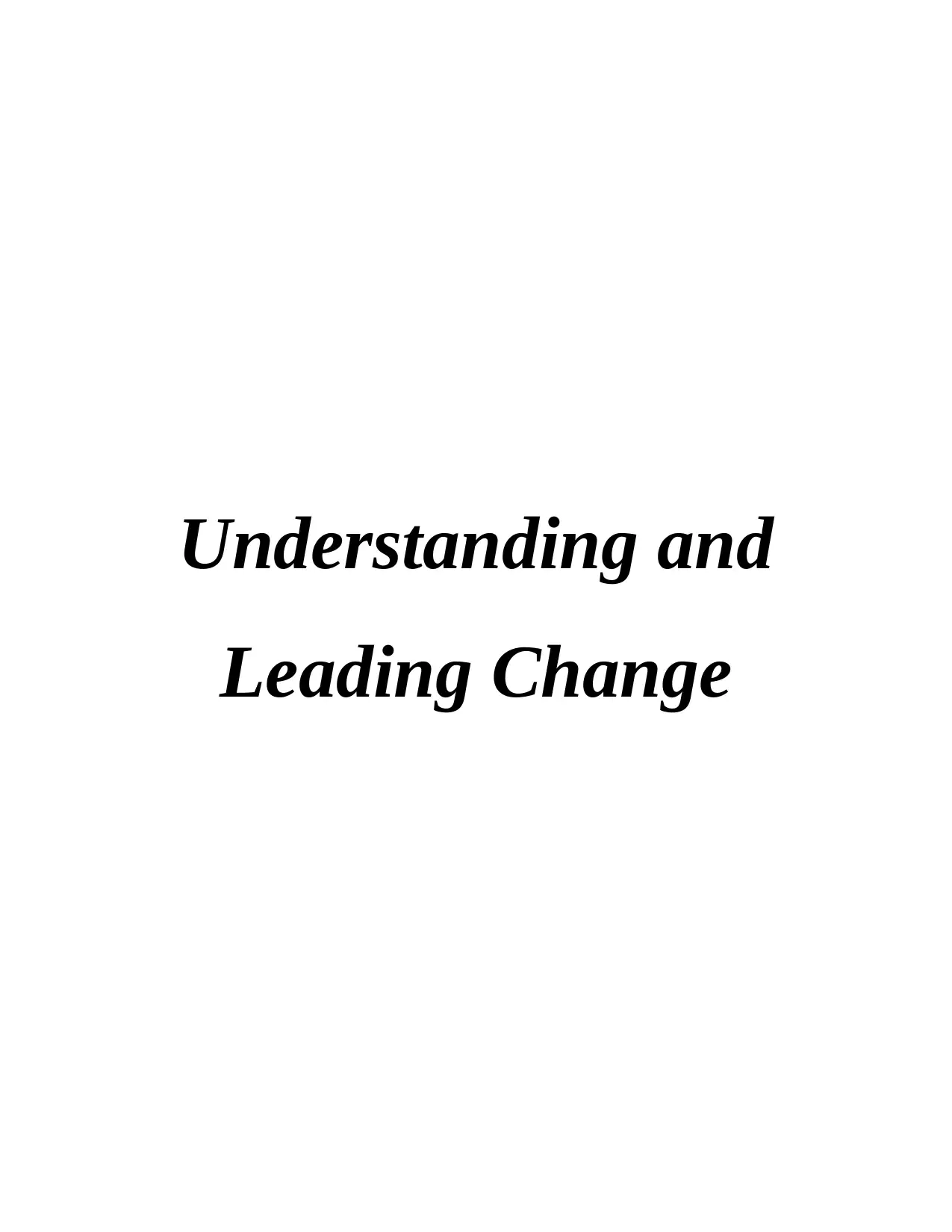
Understanding and
Leading Change
Leading Change
Paraphrase This Document
Need a fresh take? Get an instant paraphrase of this document with our AI Paraphraser

Table of Contents
INTRODUCTION...........................................................................................................................3
TASK 1............................................................................................................................................4
P1 Compare different organisational and impact of change on an organisation’s strategy and
operations....................................................................................................................................4
TASK 2............................................................................................................................................5
P2 Internal and external drivers of change affect leadership, team and individual behaviours
within an organisation.................................................................................................................5
P3 Evaluate measures that can be taken to minimise negative impacts of change on
organisational behaviour.............................................................................................................7
TASK 3............................................................................................................................................8
P4 Explain different barriers for change and determine how they influence leadership
decision-making in a given organisational context.....................................................................8
TASK 4..........................................................................................................................................10
P5 Apply different leadership approaches to dealing with change in a range of organisational
contexts.....................................................................................................................................10
CONCLUSION..............................................................................................................................11
REFERENCES..............................................................................................................................12
INTRODUCTION...........................................................................................................................3
TASK 1............................................................................................................................................4
P1 Compare different organisational and impact of change on an organisation’s strategy and
operations....................................................................................................................................4
TASK 2............................................................................................................................................5
P2 Internal and external drivers of change affect leadership, team and individual behaviours
within an organisation.................................................................................................................5
P3 Evaluate measures that can be taken to minimise negative impacts of change on
organisational behaviour.............................................................................................................7
TASK 3............................................................................................................................................8
P4 Explain different barriers for change and determine how they influence leadership
decision-making in a given organisational context.....................................................................8
TASK 4..........................................................................................................................................10
P5 Apply different leadership approaches to dealing with change in a range of organisational
contexts.....................................................................................................................................10
CONCLUSION..............................................................................................................................11
REFERENCES..............................................................................................................................12

INTRODUCTION
Change management is define as procedure, tools as well as method in order to manage
the people to adopt change to accomplish aims and objectives of organisation (Baporikar, 2017).
It is necessary because it helps in dealing with external environment in effective manner. The
main aim of change management is to implement strategies for effecting change and helping
people to adopt to change. This report is based of AEGON organisation which belongs to
financial services industry. This company was founded in 1983 and serve its services at global
level. The headquarter is located in The Hague, Netherlands. AEGON company deals in the
services of life insurance, assets management as well as pensions. This report describes about
changes in business operation and strategies in an organisation. Along with this, it also explains
about internal and external drivers which directly or indirectly affect leadership, team and
individual behaviour of a company. In addition to this, in order to minimise negative impact of
change on organisation behaviour various measure has been adopted by company. Therefore
there are various leadership approaches and it is adopted as per the structure of the organisation.
TASK 1
P1 Compare different organisational and impact of change on an organisation’s strategy and
operations.
Modification in an organisation is important for the organisation in order to compete at
competitive marketplace and satisfy customer by providing them quality goods and services.
Respective company has been compare with Prudential financial in order to know the impact of
change in organisation operation and strategies which is explained as below:
Aegon (Change in structure) Prudential financial
It is a international organisation which deals in
the services of asset management, life insurance
as well as pensions (Bason, 2017). The
organisational structure of this company is
hierarchical in which order and instruction are
It is an American Fortune Global 500 and
Fortune 500 company which deals in the
services as well as products of retirement,
annuity, real estate, life insurance and
mutual funds. The organisational structure of
Change management is define as procedure, tools as well as method in order to manage
the people to adopt change to accomplish aims and objectives of organisation (Baporikar, 2017).
It is necessary because it helps in dealing with external environment in effective manner. The
main aim of change management is to implement strategies for effecting change and helping
people to adopt to change. This report is based of AEGON organisation which belongs to
financial services industry. This company was founded in 1983 and serve its services at global
level. The headquarter is located in The Hague, Netherlands. AEGON company deals in the
services of life insurance, assets management as well as pensions. This report describes about
changes in business operation and strategies in an organisation. Along with this, it also explains
about internal and external drivers which directly or indirectly affect leadership, team and
individual behaviour of a company. In addition to this, in order to minimise negative impact of
change on organisation behaviour various measure has been adopted by company. Therefore
there are various leadership approaches and it is adopted as per the structure of the organisation.
TASK 1
P1 Compare different organisational and impact of change on an organisation’s strategy and
operations.
Modification in an organisation is important for the organisation in order to compete at
competitive marketplace and satisfy customer by providing them quality goods and services.
Respective company has been compare with Prudential financial in order to know the impact of
change in organisation operation and strategies which is explained as below:
Aegon (Change in structure) Prudential financial
It is a international organisation which deals in
the services of asset management, life insurance
as well as pensions (Bason, 2017). The
organisational structure of this company is
hierarchical in which order and instruction are
It is an American Fortune Global 500 and
Fortune 500 company which deals in the
services as well as products of retirement,
annuity, real estate, life insurance and
mutual funds. The organisational structure of
⊘ This is a preview!⊘
Do you want full access?
Subscribe today to unlock all pages.

Trusted by 1+ million students worldwide
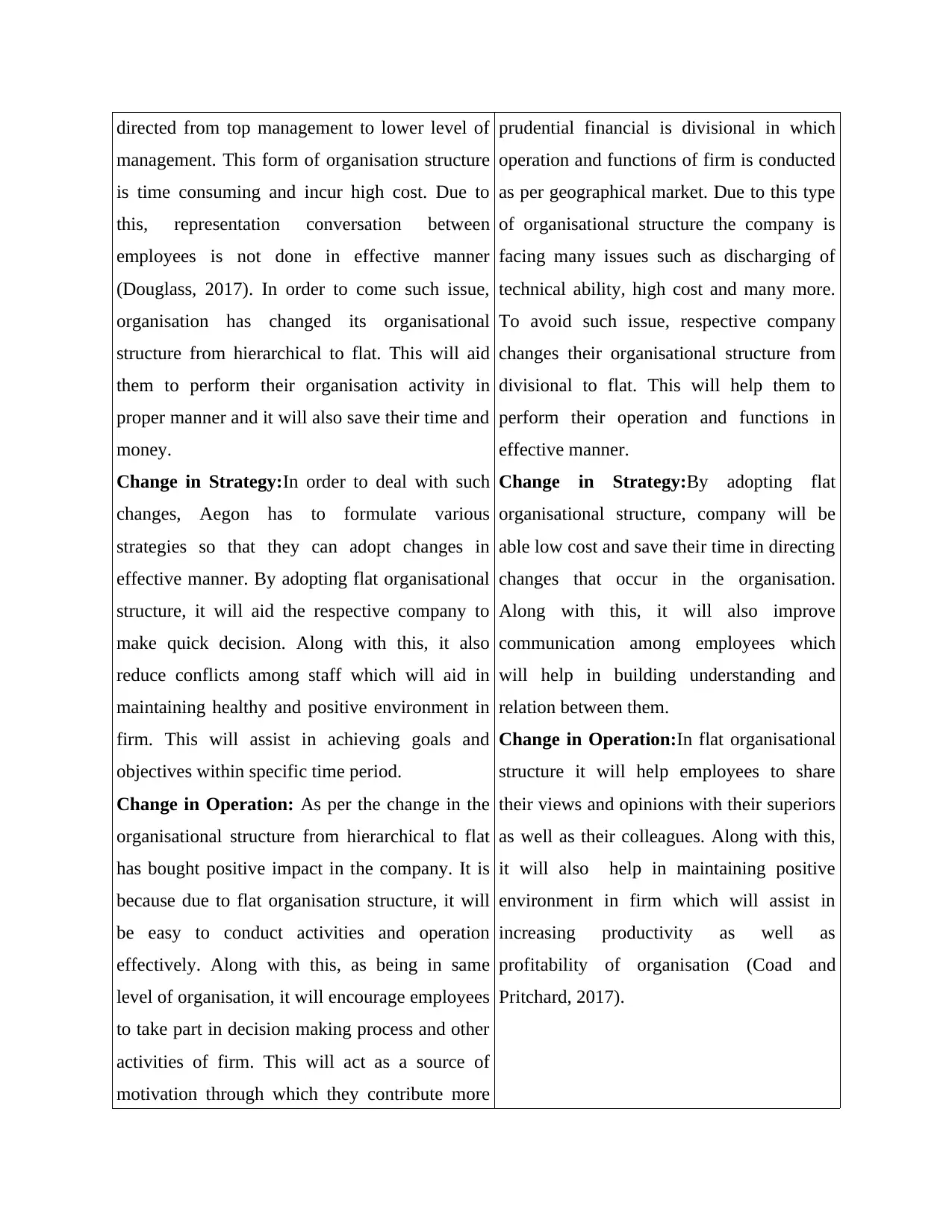
directed from top management to lower level of
management. This form of organisation structure
is time consuming and incur high cost. Due to
this, representation conversation between
employees is not done in effective manner
(Douglass, 2017). In order to come such issue,
organisation has changed its organisational
structure from hierarchical to flat. This will aid
them to perform their organisation activity in
proper manner and it will also save their time and
money.
Change in Strategy:In order to deal with such
changes, Aegon has to formulate various
strategies so that they can adopt changes in
effective manner. By adopting flat organisational
structure, it will aid the respective company to
make quick decision. Along with this, it also
reduce conflicts among staff which will aid in
maintaining healthy and positive environment in
firm. This will assist in achieving goals and
objectives within specific time period.
Change in Operation: As per the change in the
organisational structure from hierarchical to flat
has bought positive impact in the company. It is
because due to flat organisation structure, it will
be easy to conduct activities and operation
effectively. Along with this, as being in same
level of organisation, it will encourage employees
to take part in decision making process and other
activities of firm. This will act as a source of
motivation through which they contribute more
prudential financial is divisional in which
operation and functions of firm is conducted
as per geographical market. Due to this type
of organisational structure the company is
facing many issues such as discharging of
technical ability, high cost and many more.
To avoid such issue, respective company
changes their organisational structure from
divisional to flat. This will help them to
perform their operation and functions in
effective manner.
Change in Strategy:By adopting flat
organisational structure, company will be
able low cost and save their time in directing
changes that occur in the organisation.
Along with this, it will also improve
communication among employees which
will help in building understanding and
relation between them.
Change in Operation:In flat organisational
structure it will help employees to share
their views and opinions with their superiors
as well as their colleagues. Along with this,
it will also help in maintaining positive
environment in firm which will assist in
increasing productivity as well as
profitability of organisation (Coad and
Pritchard, 2017).
management. This form of organisation structure
is time consuming and incur high cost. Due to
this, representation conversation between
employees is not done in effective manner
(Douglass, 2017). In order to come such issue,
organisation has changed its organisational
structure from hierarchical to flat. This will aid
them to perform their organisation activity in
proper manner and it will also save their time and
money.
Change in Strategy:In order to deal with such
changes, Aegon has to formulate various
strategies so that they can adopt changes in
effective manner. By adopting flat organisational
structure, it will aid the respective company to
make quick decision. Along with this, it also
reduce conflicts among staff which will aid in
maintaining healthy and positive environment in
firm. This will assist in achieving goals and
objectives within specific time period.
Change in Operation: As per the change in the
organisational structure from hierarchical to flat
has bought positive impact in the company. It is
because due to flat organisation structure, it will
be easy to conduct activities and operation
effectively. Along with this, as being in same
level of organisation, it will encourage employees
to take part in decision making process and other
activities of firm. This will act as a source of
motivation through which they contribute more
prudential financial is divisional in which
operation and functions of firm is conducted
as per geographical market. Due to this type
of organisational structure the company is
facing many issues such as discharging of
technical ability, high cost and many more.
To avoid such issue, respective company
changes their organisational structure from
divisional to flat. This will help them to
perform their operation and functions in
effective manner.
Change in Strategy:By adopting flat
organisational structure, company will be
able low cost and save their time in directing
changes that occur in the organisation.
Along with this, it will also improve
communication among employees which
will help in building understanding and
relation between them.
Change in Operation:In flat organisational
structure it will help employees to share
their views and opinions with their superiors
as well as their colleagues. Along with this,
it will also help in maintaining positive
environment in firm which will assist in
increasing productivity as well as
profitability of organisation (Coad and
Pritchard, 2017).
Paraphrase This Document
Need a fresh take? Get an instant paraphrase of this document with our AI Paraphraser
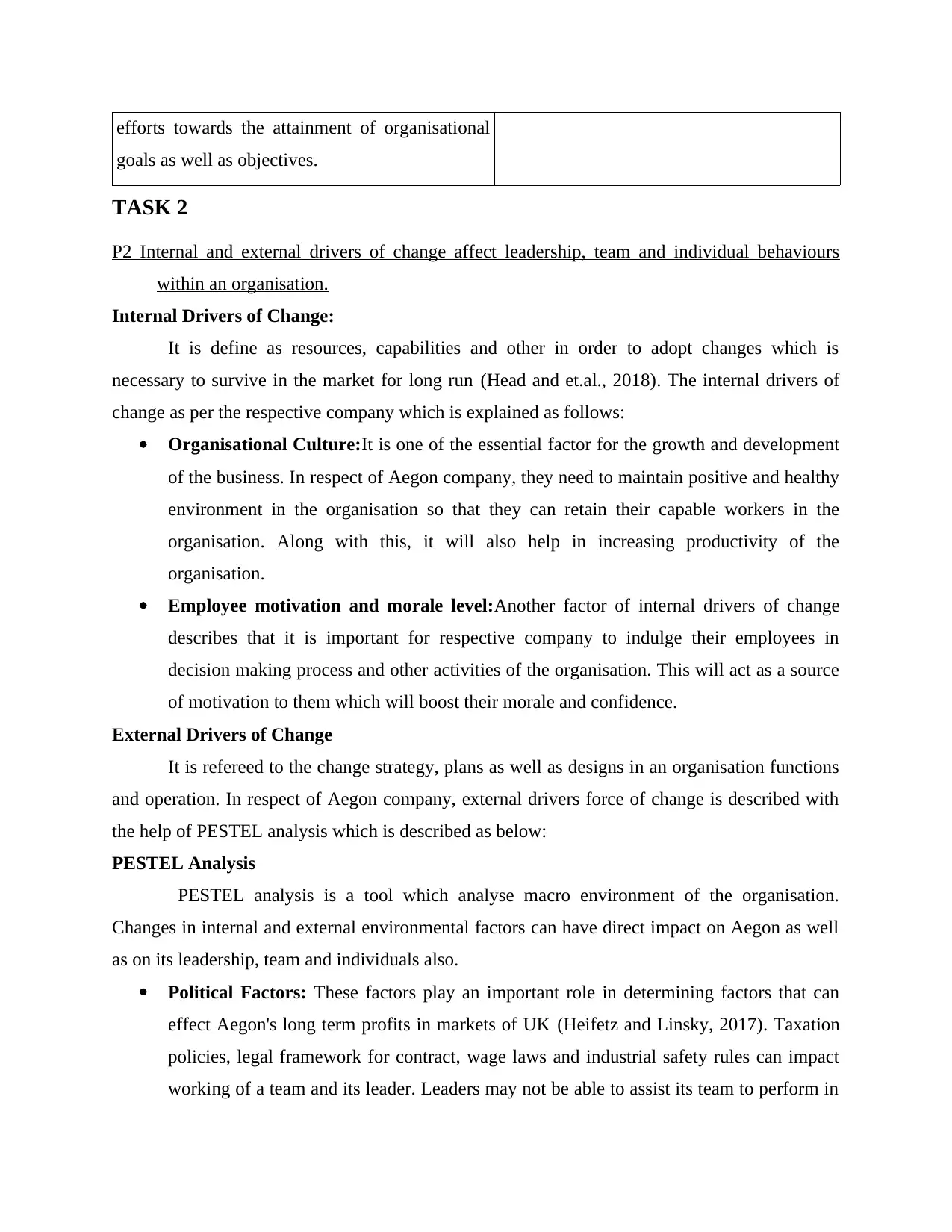
efforts towards the attainment of organisational
goals as well as objectives.
TASK 2
P2 Internal and external drivers of change affect leadership, team and individual behaviours
within an organisation.
Internal Drivers of Change:
It is define as resources, capabilities and other in order to adopt changes which is
necessary to survive in the market for long run (Head and et.al., 2018). The internal drivers of
change as per the respective company which is explained as follows:
Organisational Culture:It is one of the essential factor for the growth and development
of the business. In respect of Aegon company, they need to maintain positive and healthy
environment in the organisation so that they can retain their capable workers in the
organisation. Along with this, it will also help in increasing productivity of the
organisation.
Employee motivation and morale level:Another factor of internal drivers of change
describes that it is important for respective company to indulge their employees in
decision making process and other activities of the organisation. This will act as a source
of motivation to them which will boost their morale and confidence.
External Drivers of Change
It is refereed to the change strategy, plans as well as designs in an organisation functions
and operation. In respect of Aegon company, external drivers force of change is described with
the help of PESTEL analysis which is described as below:
PESTEL Analysis
PESTEL analysis is a tool which analyse macro environment of the organisation.
Changes in internal and external environmental factors can have direct impact on Aegon as well
as on its leadership, team and individuals also.
Political Factors: These factors play an important role in determining factors that can
effect Aegon's long term profits in markets of UK (Heifetz and Linsky, 2017). Taxation
policies, legal framework for contract, wage laws and industrial safety rules can impact
working of a team and its leader. Leaders may not be able to assist its team to perform in
goals as well as objectives.
TASK 2
P2 Internal and external drivers of change affect leadership, team and individual behaviours
within an organisation.
Internal Drivers of Change:
It is define as resources, capabilities and other in order to adopt changes which is
necessary to survive in the market for long run (Head and et.al., 2018). The internal drivers of
change as per the respective company which is explained as follows:
Organisational Culture:It is one of the essential factor for the growth and development
of the business. In respect of Aegon company, they need to maintain positive and healthy
environment in the organisation so that they can retain their capable workers in the
organisation. Along with this, it will also help in increasing productivity of the
organisation.
Employee motivation and morale level:Another factor of internal drivers of change
describes that it is important for respective company to indulge their employees in
decision making process and other activities of the organisation. This will act as a source
of motivation to them which will boost their morale and confidence.
External Drivers of Change
It is refereed to the change strategy, plans as well as designs in an organisation functions
and operation. In respect of Aegon company, external drivers force of change is described with
the help of PESTEL analysis which is described as below:
PESTEL Analysis
PESTEL analysis is a tool which analyse macro environment of the organisation.
Changes in internal and external environmental factors can have direct impact on Aegon as well
as on its leadership, team and individuals also.
Political Factors: These factors play an important role in determining factors that can
effect Aegon's long term profits in markets of UK (Heifetz and Linsky, 2017). Taxation
policies, legal framework for contract, wage laws and industrial safety rules can impact
working of a team and its leader. Leaders may not be able to assist its team to perform in

such conditions. Due to inappropriate wage distribution law individuals can be
demotivate to work for this industry.
Economic Factors: In respect to Aegon, economic factors such as exchange, economic
growth rates, unemployment, inflation and interest rates can affect working of leaders and
its team also to perform their regular activities (Hickman, Riemer and YLEC, 2016).
These factors can affect working of an organisation when unemployment and inflation
rate decreases by developing opportunities for business growth and provide a chance for
individuals to get employment.
Social Factors: Society's culture, shared beliefs and attitudes of population play a
significant role to understand customers and design of marketing message for this life
insurance industry. In context to Aegon, this can create difficulties for team leaders
members to understand needs of peoples with different demographic factors. Individuals
can perform better with positive attitude and entrepreneurial spirit.
Technological Factors: Changes in technologies of competitors can affect working of
team members and responsibilities of team leaders also. Due to changes in techniques of
this insurance company this can affect cost and value chain structure. All these factors
affect working of individuals and team leaders in an organisation. Up gradation of
technology can also helps individuals to develop in this competitive market.
Environmental Factors: Aegon has to analyse environmental standards before operating
its business operations at any marketplace. Team leaders can initiate towards waste
management and use of ecological products in an administration. This can motivate team
members and individuals to take care of environment of their organisation and outside
their firm. Weather and climate change can increase absenteeism and reduce
effectiveness in working of individuals.
Legal Factors: Different employment laws, health and safety laws encourage individuals
working in Aegon to enjoy all these laws and benefits in their organisation (Hurst and
Hurst, 2016). So it should follow all rules and regulations mentioned in the laws which
can affect working and increase conflicts in an organisation.
demotivate to work for this industry.
Economic Factors: In respect to Aegon, economic factors such as exchange, economic
growth rates, unemployment, inflation and interest rates can affect working of leaders and
its team also to perform their regular activities (Hickman, Riemer and YLEC, 2016).
These factors can affect working of an organisation when unemployment and inflation
rate decreases by developing opportunities for business growth and provide a chance for
individuals to get employment.
Social Factors: Society's culture, shared beliefs and attitudes of population play a
significant role to understand customers and design of marketing message for this life
insurance industry. In context to Aegon, this can create difficulties for team leaders
members to understand needs of peoples with different demographic factors. Individuals
can perform better with positive attitude and entrepreneurial spirit.
Technological Factors: Changes in technologies of competitors can affect working of
team members and responsibilities of team leaders also. Due to changes in techniques of
this insurance company this can affect cost and value chain structure. All these factors
affect working of individuals and team leaders in an organisation. Up gradation of
technology can also helps individuals to develop in this competitive market.
Environmental Factors: Aegon has to analyse environmental standards before operating
its business operations at any marketplace. Team leaders can initiate towards waste
management and use of ecological products in an administration. This can motivate team
members and individuals to take care of environment of their organisation and outside
their firm. Weather and climate change can increase absenteeism and reduce
effectiveness in working of individuals.
Legal Factors: Different employment laws, health and safety laws encourage individuals
working in Aegon to enjoy all these laws and benefits in their organisation (Hurst and
Hurst, 2016). So it should follow all rules and regulations mentioned in the laws which
can affect working and increase conflicts in an organisation.
⊘ This is a preview!⊘
Do you want full access?
Subscribe today to unlock all pages.

Trusted by 1+ million students worldwide
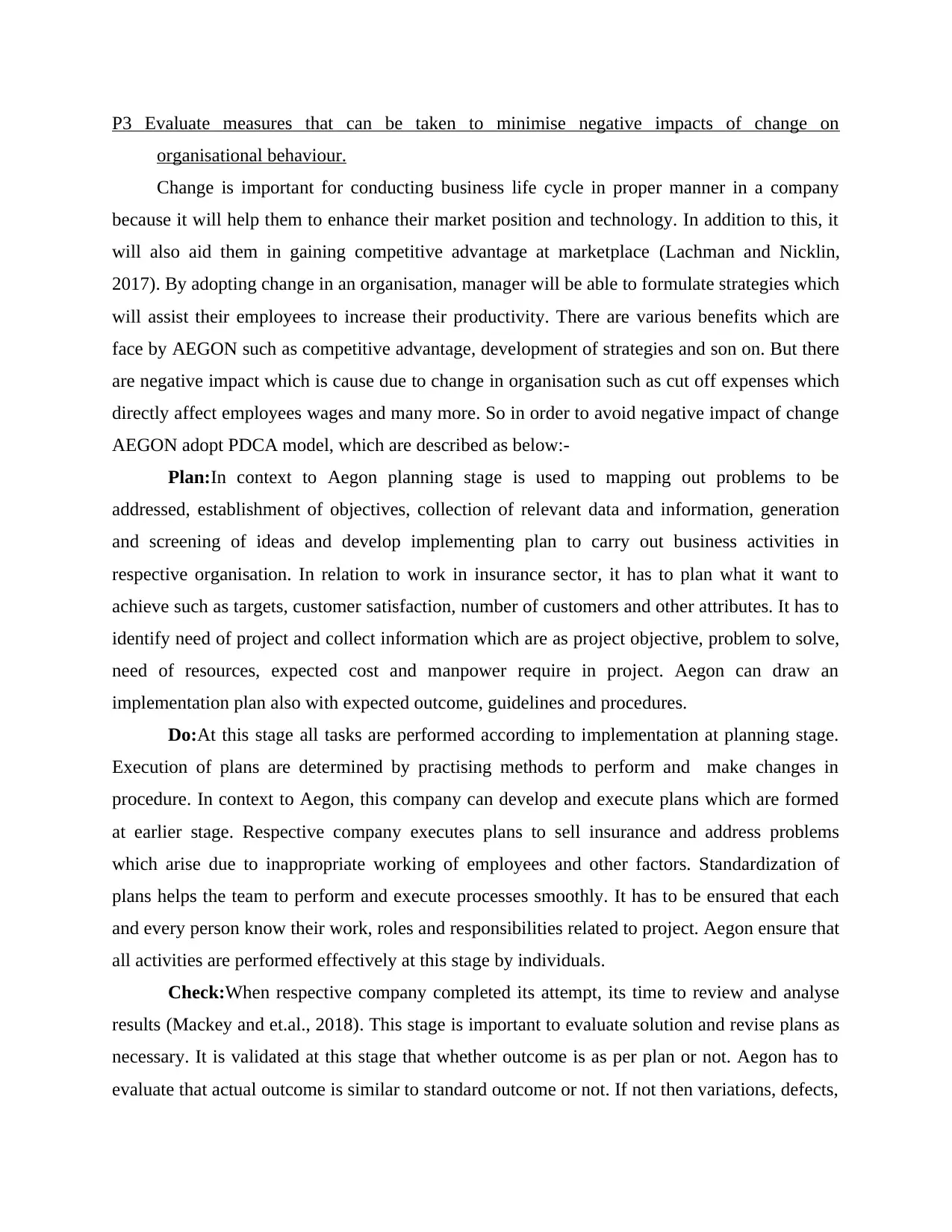
P3 Evaluate measures that can be taken to minimise negative impacts of change on
organisational behaviour.
Change is important for conducting business life cycle in proper manner in a company
because it will help them to enhance their market position and technology. In addition to this, it
will also aid them in gaining competitive advantage at marketplace (Lachman and Nicklin,
2017). By adopting change in an organisation, manager will be able to formulate strategies which
will assist their employees to increase their productivity. There are various benefits which are
face by AEGON such as competitive advantage, development of strategies and son on. But there
are negative impact which is cause due to change in organisation such as cut off expenses which
directly affect employees wages and many more. So in order to avoid negative impact of change
AEGON adopt PDCA model, which are described as below:-
Plan:In context to Aegon planning stage is used to mapping out problems to be
addressed, establishment of objectives, collection of relevant data and information, generation
and screening of ideas and develop implementing plan to carry out business activities in
respective organisation. In relation to work in insurance sector, it has to plan what it want to
achieve such as targets, customer satisfaction, number of customers and other attributes. It has to
identify need of project and collect information which are as project objective, problem to solve,
need of resources, expected cost and manpower require in project. Aegon can draw an
implementation plan also with expected outcome, guidelines and procedures.
Do:At this stage all tasks are performed according to implementation at planning stage.
Execution of plans are determined by practising methods to perform and make changes in
procedure. In context to Aegon, this company can develop and execute plans which are formed
at earlier stage. Respective company executes plans to sell insurance and address problems
which arise due to inappropriate working of employees and other factors. Standardization of
plans helps the team to perform and execute processes smoothly. It has to be ensured that each
and every person know their work, roles and responsibilities related to project. Aegon ensure that
all activities are performed effectively at this stage by individuals.
Check:When respective company completed its attempt, its time to review and analyse
results (Mackey and et.al., 2018). This stage is important to evaluate solution and revise plans as
necessary. It is validated at this stage that whether outcome is as per plan or not. Aegon has to
evaluate that actual outcome is similar to standard outcome or not. If not then variations, defects,
organisational behaviour.
Change is important for conducting business life cycle in proper manner in a company
because it will help them to enhance their market position and technology. In addition to this, it
will also aid them in gaining competitive advantage at marketplace (Lachman and Nicklin,
2017). By adopting change in an organisation, manager will be able to formulate strategies which
will assist their employees to increase their productivity. There are various benefits which are
face by AEGON such as competitive advantage, development of strategies and son on. But there
are negative impact which is cause due to change in organisation such as cut off expenses which
directly affect employees wages and many more. So in order to avoid negative impact of change
AEGON adopt PDCA model, which are described as below:-
Plan:In context to Aegon planning stage is used to mapping out problems to be
addressed, establishment of objectives, collection of relevant data and information, generation
and screening of ideas and develop implementing plan to carry out business activities in
respective organisation. In relation to work in insurance sector, it has to plan what it want to
achieve such as targets, customer satisfaction, number of customers and other attributes. It has to
identify need of project and collect information which are as project objective, problem to solve,
need of resources, expected cost and manpower require in project. Aegon can draw an
implementation plan also with expected outcome, guidelines and procedures.
Do:At this stage all tasks are performed according to implementation at planning stage.
Execution of plans are determined by practising methods to perform and make changes in
procedure. In context to Aegon, this company can develop and execute plans which are formed
at earlier stage. Respective company executes plans to sell insurance and address problems
which arise due to inappropriate working of employees and other factors. Standardization of
plans helps the team to perform and execute processes smoothly. It has to be ensured that each
and every person know their work, roles and responsibilities related to project. Aegon ensure that
all activities are performed effectively at this stage by individuals.
Check:When respective company completed its attempt, its time to review and analyse
results (Mackey and et.al., 2018). This stage is important to evaluate solution and revise plans as
necessary. It is validated at this stage that whether outcome is as per plan or not. Aegon has to
evaluate that actual outcome is similar to standard outcome or not. If not then variations, defects,
Paraphrase This Document
Need a fresh take? Get an instant paraphrase of this document with our AI Paraphraser

challenges and best practices are note down by leaders or managers to identify problems and
causes for problems. Things which are identified in this stage by respective organisation are such
as: method used in this, material, labour, machines, measures and environment. By analysing
these factors, it will assist to make working methods that can solve problems more effectively.
Act:At this stage for Aegon it is time to act. Respective company has a responsibility to
correct defects in a project and ensure that now fulfilling its specifications (Martynovich and
Lundquist, 2016). For the problems identified at previous stage its time to take preventive
actions. Respective organisation implement preventive actions and check whether outcome is as
per expectation or not. Now results of this cycle become input for 'analyse' phase in next cycle.
For next cycle these steps are repeat in same way Do-Check-Act until objectives are met to
satisfaction level of customers of this organisation.
TASK 3
P4 Explain different barriers for change and determine how they influence leadership decision-
making in a given organisational context.
While making adjustments in a firm, there may be hindrance that create space between real
procedures and normal procedures which has a adverse impact on daily activities and operation
of organisation. It is the duty of an organisation’s executives and leaders to evaluate the market
and determine obstacles and formulate policies accordingly in order to resolve the problem.
AEGON business uses the force field model to determine the changes as described below:
Force Field Analysis model:
It is one of the important tool for the company as it helps in maintaining equilibrium level
in forces in which changes are occurred. Driving forces are essential to provide measures about
area where modification are major and resisting factors which consist barriers while carrying out
changes in a company.
Driving Forces of changes:
There are different drivers of change which help firm to carry out changes in effective
manner. In terms of Aegon company, employees are demanding new pension strategies as well
as schemes and security forces which will provide them assurance for future (Nagorny-Koring,
2019). On the contrary, workers of firm request for advance and latest technology through which
they will able to save their data and perform their task in better manner.
causes for problems. Things which are identified in this stage by respective organisation are such
as: method used in this, material, labour, machines, measures and environment. By analysing
these factors, it will assist to make working methods that can solve problems more effectively.
Act:At this stage for Aegon it is time to act. Respective company has a responsibility to
correct defects in a project and ensure that now fulfilling its specifications (Martynovich and
Lundquist, 2016). For the problems identified at previous stage its time to take preventive
actions. Respective organisation implement preventive actions and check whether outcome is as
per expectation or not. Now results of this cycle become input for 'analyse' phase in next cycle.
For next cycle these steps are repeat in same way Do-Check-Act until objectives are met to
satisfaction level of customers of this organisation.
TASK 3
P4 Explain different barriers for change and determine how they influence leadership decision-
making in a given organisational context.
While making adjustments in a firm, there may be hindrance that create space between real
procedures and normal procedures which has a adverse impact on daily activities and operation
of organisation. It is the duty of an organisation’s executives and leaders to evaluate the market
and determine obstacles and formulate policies accordingly in order to resolve the problem.
AEGON business uses the force field model to determine the changes as described below:
Force Field Analysis model:
It is one of the important tool for the company as it helps in maintaining equilibrium level
in forces in which changes are occurred. Driving forces are essential to provide measures about
area where modification are major and resisting factors which consist barriers while carrying out
changes in a company.
Driving Forces of changes:
There are different drivers of change which help firm to carry out changes in effective
manner. In terms of Aegon company, employees are demanding new pension strategies as well
as schemes and security forces which will provide them assurance for future (Nagorny-Koring,
2019). On the contrary, workers of firm request for advance and latest technology through which
they will able to save their data and perform their task in better manner.
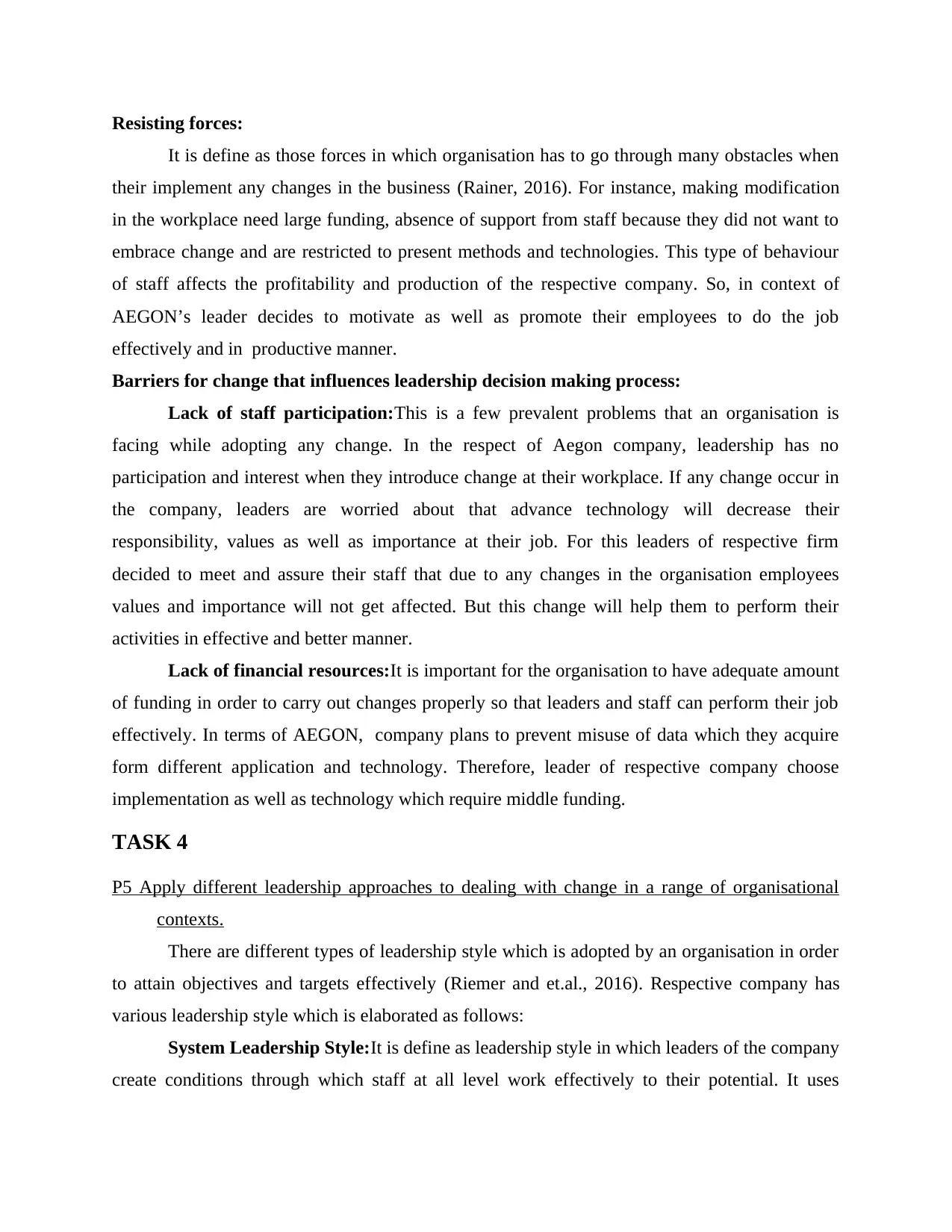
Resisting forces:
It is define as those forces in which organisation has to go through many obstacles when
their implement any changes in the business (Rainer, 2016). For instance, making modification
in the workplace need large funding, absence of support from staff because they did not want to
embrace change and are restricted to present methods and technologies. This type of behaviour
of staff affects the profitability and production of the respective company. So, in context of
AEGON’s leader decides to motivate as well as promote their employees to do the job
effectively and in productive manner.
Barriers for change that influences leadership decision making process:
Lack of staff participation:This is a few prevalent problems that an organisation is
facing while adopting any change. In the respect of Aegon company, leadership has no
participation and interest when they introduce change at their workplace. If any change occur in
the company, leaders are worried about that advance technology will decrease their
responsibility, values as well as importance at their job. For this leaders of respective firm
decided to meet and assure their staff that due to any changes in the organisation employees
values and importance will not get affected. But this change will help them to perform their
activities in effective and better manner.
Lack of financial resources:It is important for the organisation to have adequate amount
of funding in order to carry out changes properly so that leaders and staff can perform their job
effectively. In terms of AEGON, company plans to prevent misuse of data which they acquire
form different application and technology. Therefore, leader of respective company choose
implementation as well as technology which require middle funding.
TASK 4
P5 Apply different leadership approaches to dealing with change in a range of organisational
contexts.
There are different types of leadership style which is adopted by an organisation in order
to attain objectives and targets effectively (Riemer and et.al., 2016). Respective company has
various leadership style which is elaborated as follows:
System Leadership Style:It is define as leadership style in which leaders of the company
create conditions through which staff at all level work effectively to their potential. It uses
It is define as those forces in which organisation has to go through many obstacles when
their implement any changes in the business (Rainer, 2016). For instance, making modification
in the workplace need large funding, absence of support from staff because they did not want to
embrace change and are restricted to present methods and technologies. This type of behaviour
of staff affects the profitability and production of the respective company. So, in context of
AEGON’s leader decides to motivate as well as promote their employees to do the job
effectively and in productive manner.
Barriers for change that influences leadership decision making process:
Lack of staff participation:This is a few prevalent problems that an organisation is
facing while adopting any change. In the respect of Aegon company, leadership has no
participation and interest when they introduce change at their workplace. If any change occur in
the company, leaders are worried about that advance technology will decrease their
responsibility, values as well as importance at their job. For this leaders of respective firm
decided to meet and assure their staff that due to any changes in the organisation employees
values and importance will not get affected. But this change will help them to perform their
activities in effective and better manner.
Lack of financial resources:It is important for the organisation to have adequate amount
of funding in order to carry out changes properly so that leaders and staff can perform their job
effectively. In terms of AEGON, company plans to prevent misuse of data which they acquire
form different application and technology. Therefore, leader of respective company choose
implementation as well as technology which require middle funding.
TASK 4
P5 Apply different leadership approaches to dealing with change in a range of organisational
contexts.
There are different types of leadership style which is adopted by an organisation in order
to attain objectives and targets effectively (Riemer and et.al., 2016). Respective company has
various leadership style which is elaborated as follows:
System Leadership Style:It is define as leadership style in which leaders of the company
create conditions through which staff at all level work effectively to their potential. It uses
⊘ This is a preview!⊘
Do you want full access?
Subscribe today to unlock all pages.

Trusted by 1+ million students worldwide

principles about human behaviour in order to create models of good leadership, organisational
strategy, system designs as well as social process. In reference of Aegon organisation, this
leadership style will enable them to coordinate their task in better and productive manner which
will help them to accomplish objectives properly.
Kurt Lewin's change model:
This model represent about types of changes and its importance in an organisation. In this
model there are three components i.e. unfreezing, changing and refreezing. These elements is
describes as follows:
Unfreezing:In respect of AEGON Company’s chief or executives accept adjustments and
determine from their leadership that certain changes are required in a company. For
example, the respective business has determined that they are required to change their
advertisement method which they are presently using. Before the organisation advertise
their services through print media such as newspaper, magazines and many more but now
they decide to advertise through digital as well as social media for which they are
authorized by current employers.
Changing:In this stage, employees begin to solve their issues and look for implementing
new things. Along with this, they start to believe and act in the manner which support
new direction (Wilkinson, 2017). In respect of Aegon organisation, leaders encourage as
well as provide information to staff so that they can work together to achieve their
objectives.
Refreezing:In the last stage of respective model, it describes about when changes start
taking shape and employees are able to adopt themselves as per the change, then
organisation begin to refreeze. In context of respective organisation, refreezing stage will
bring a new sense of stability, workers will be more confident as well as comfortable in
working with different methods.
CONCLUSION
From the above report, it has been concluded that change is important for the
organisation for growth and development of the company. In order to implement change in
effective manner, firm measure effective strategies in every factor so that negative impact of
external environment does not impact the function and operation of organisation. Along with
this, it is essential for the organisation to analyse the driving forces effectively which will help
strategy, system designs as well as social process. In reference of Aegon organisation, this
leadership style will enable them to coordinate their task in better and productive manner which
will help them to accomplish objectives properly.
Kurt Lewin's change model:
This model represent about types of changes and its importance in an organisation. In this
model there are three components i.e. unfreezing, changing and refreezing. These elements is
describes as follows:
Unfreezing:In respect of AEGON Company’s chief or executives accept adjustments and
determine from their leadership that certain changes are required in a company. For
example, the respective business has determined that they are required to change their
advertisement method which they are presently using. Before the organisation advertise
their services through print media such as newspaper, magazines and many more but now
they decide to advertise through digital as well as social media for which they are
authorized by current employers.
Changing:In this stage, employees begin to solve their issues and look for implementing
new things. Along with this, they start to believe and act in the manner which support
new direction (Wilkinson, 2017). In respect of Aegon organisation, leaders encourage as
well as provide information to staff so that they can work together to achieve their
objectives.
Refreezing:In the last stage of respective model, it describes about when changes start
taking shape and employees are able to adopt themselves as per the change, then
organisation begin to refreeze. In context of respective organisation, refreezing stage will
bring a new sense of stability, workers will be more confident as well as comfortable in
working with different methods.
CONCLUSION
From the above report, it has been concluded that change is important for the
organisation for growth and development of the company. In order to implement change in
effective manner, firm measure effective strategies in every factor so that negative impact of
external environment does not impact the function and operation of organisation. Along with
this, it is essential for the organisation to analyse the driving forces effectively which will help
Paraphrase This Document
Need a fresh take? Get an instant paraphrase of this document with our AI Paraphraser
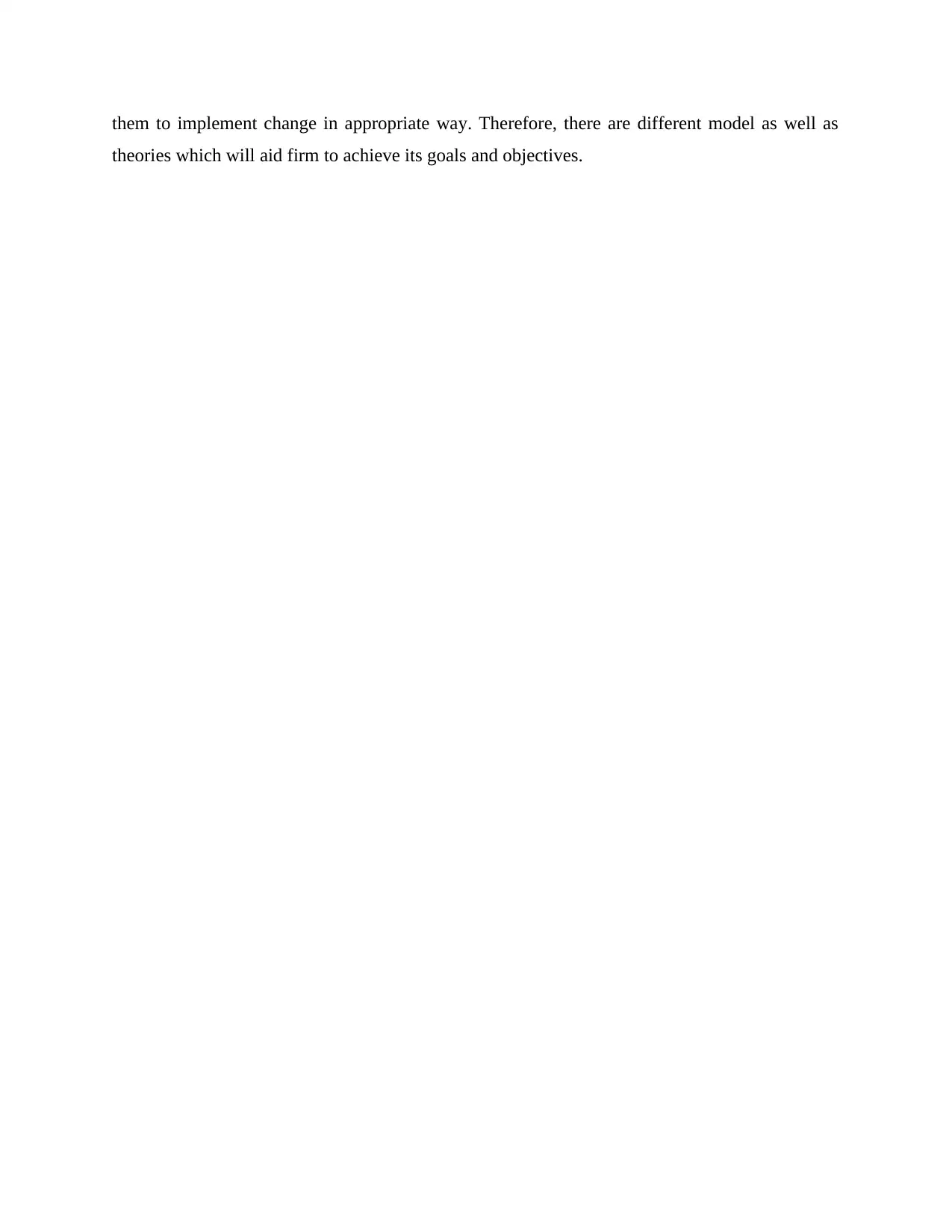
them to implement change in appropriate way. Therefore, there are different model as well as
theories which will aid firm to achieve its goals and objectives.
theories which will aid firm to achieve its goals and objectives.
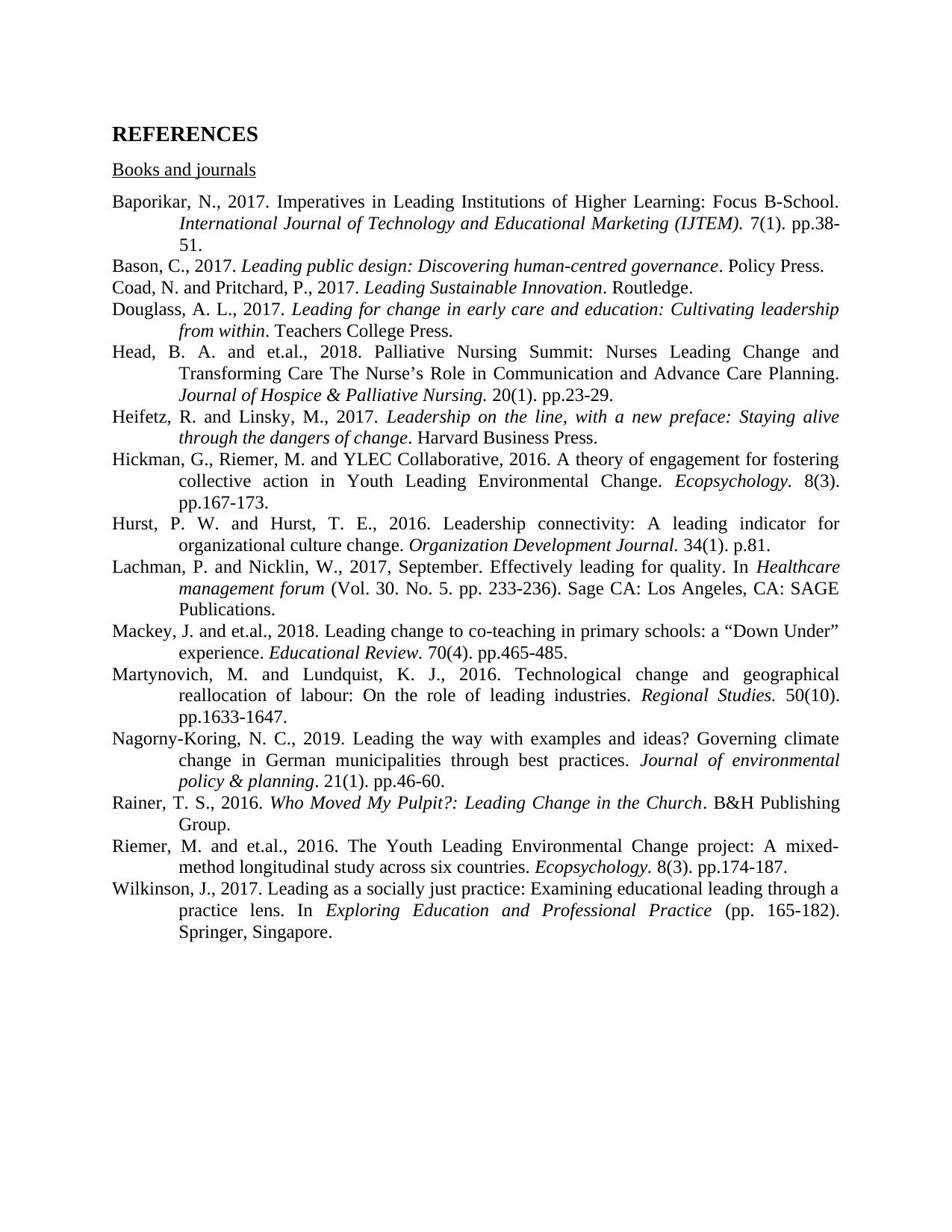
REFERENCES
Books and journals
Baporikar, N., 2017. Imperatives in Leading Institutions of Higher Learning: Focus B-School.
International Journal of Technology and Educational Marketing (IJTEM). 7(1). pp.38-
51.
Bason, C., 2017. Leading public design: Discovering human-centred governance. Policy Press.
Coad, N. and Pritchard, P., 2017. Leading Sustainable Innovation. Routledge.
Douglass, A. L., 2017. Leading for change in early care and education: Cultivating leadership
from within. Teachers College Press.
Head, B. A. and et.al., 2018. Palliative Nursing Summit: Nurses Leading Change and
Transforming Care The Nurse’s Role in Communication and Advance Care Planning.
Journal of Hospice & Palliative Nursing. 20(1). pp.23-29.
Heifetz, R. and Linsky, M., 2017. Leadership on the line, with a new preface: Staying alive
through the dangers of change. Harvard Business Press.
Hickman, G., Riemer, M. and YLEC Collaborative, 2016. A theory of engagement for fostering
collective action in Youth Leading Environmental Change. Ecopsychology. 8(3).
pp.167-173.
Hurst, P. W. and Hurst, T. E., 2016. Leadership connectivity: A leading indicator for
organizational culture change. Organization Development Journal. 34(1). p.81.
Lachman, P. and Nicklin, W., 2017, September. Effectively leading for quality. In Healthcare
management forum (Vol. 30. No. 5. pp. 233-236). Sage CA: Los Angeles, CA: SAGE
Publications.
Mackey, J. and et.al., 2018. Leading change to co-teaching in primary schools: a “Down Under”
experience. Educational Review. 70(4). pp.465-485.
Martynovich, M. and Lundquist, K. J., 2016. Technological change and geographical
reallocation of labour: On the role of leading industries. Regional Studies. 50(10).
pp.1633-1647.
Nagorny-Koring, N. C., 2019. Leading the way with examples and ideas? Governing climate
change in German municipalities through best practices. Journal of environmental
policy & planning. 21(1). pp.46-60.
Rainer, T. S., 2016. Who Moved My Pulpit?: Leading Change in the Church. B&H Publishing
Group.
Riemer, M. and et.al., 2016. The Youth Leading Environmental Change project: A mixed-
method longitudinal study across six countries. Ecopsychology. 8(3). pp.174-187.
Wilkinson, J., 2017. Leading as a socially just practice: Examining educational leading through a
practice lens. In Exploring Education and Professional Practice (pp. 165-182).
Springer, Singapore.
Books and journals
Baporikar, N., 2017. Imperatives in Leading Institutions of Higher Learning: Focus B-School.
International Journal of Technology and Educational Marketing (IJTEM). 7(1). pp.38-
51.
Bason, C., 2017. Leading public design: Discovering human-centred governance. Policy Press.
Coad, N. and Pritchard, P., 2017. Leading Sustainable Innovation. Routledge.
Douglass, A. L., 2017. Leading for change in early care and education: Cultivating leadership
from within. Teachers College Press.
Head, B. A. and et.al., 2018. Palliative Nursing Summit: Nurses Leading Change and
Transforming Care The Nurse’s Role in Communication and Advance Care Planning.
Journal of Hospice & Palliative Nursing. 20(1). pp.23-29.
Heifetz, R. and Linsky, M., 2017. Leadership on the line, with a new preface: Staying alive
through the dangers of change. Harvard Business Press.
Hickman, G., Riemer, M. and YLEC Collaborative, 2016. A theory of engagement for fostering
collective action in Youth Leading Environmental Change. Ecopsychology. 8(3).
pp.167-173.
Hurst, P. W. and Hurst, T. E., 2016. Leadership connectivity: A leading indicator for
organizational culture change. Organization Development Journal. 34(1). p.81.
Lachman, P. and Nicklin, W., 2017, September. Effectively leading for quality. In Healthcare
management forum (Vol. 30. No. 5. pp. 233-236). Sage CA: Los Angeles, CA: SAGE
Publications.
Mackey, J. and et.al., 2018. Leading change to co-teaching in primary schools: a “Down Under”
experience. Educational Review. 70(4). pp.465-485.
Martynovich, M. and Lundquist, K. J., 2016. Technological change and geographical
reallocation of labour: On the role of leading industries. Regional Studies. 50(10).
pp.1633-1647.
Nagorny-Koring, N. C., 2019. Leading the way with examples and ideas? Governing climate
change in German municipalities through best practices. Journal of environmental
policy & planning. 21(1). pp.46-60.
Rainer, T. S., 2016. Who Moved My Pulpit?: Leading Change in the Church. B&H Publishing
Group.
Riemer, M. and et.al., 2016. The Youth Leading Environmental Change project: A mixed-
method longitudinal study across six countries. Ecopsychology. 8(3). pp.174-187.
Wilkinson, J., 2017. Leading as a socially just practice: Examining educational leading through a
practice lens. In Exploring Education and Professional Practice (pp. 165-182).
Springer, Singapore.
⊘ This is a preview!⊘
Do you want full access?
Subscribe today to unlock all pages.

Trusted by 1+ million students worldwide
1 out of 12
Related Documents
Your All-in-One AI-Powered Toolkit for Academic Success.
+13062052269
info@desklib.com
Available 24*7 on WhatsApp / Email
![[object Object]](/_next/static/media/star-bottom.7253800d.svg)
Unlock your academic potential
Copyright © 2020–2025 A2Z Services. All Rights Reserved. Developed and managed by ZUCOL.





